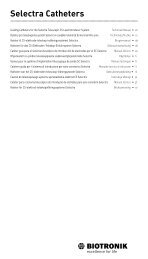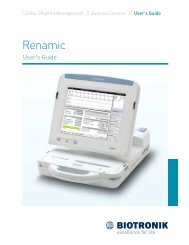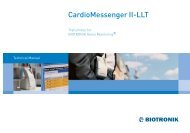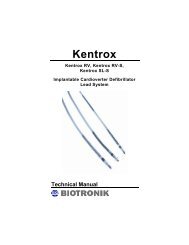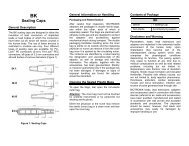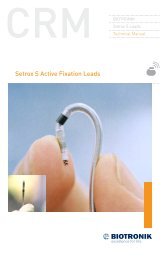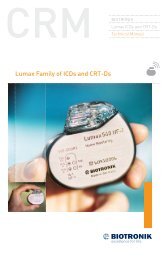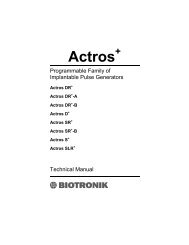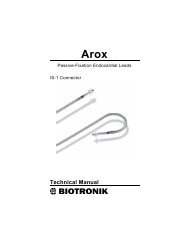Estella Pulse Generators - BIOTRONIK USA - News
Estella Pulse Generators - BIOTRONIK USA - News
Estella Pulse Generators - BIOTRONIK USA - News
Create successful ePaper yourself
Turn your PDF publications into a flip-book with our unique Google optimized e-Paper software.
<strong>Estella</strong> <strong>Pulse</strong> <strong>Generators</strong> Technical Manual 43Overall, the V pS group (Group 1) had a much lower percentage ofventricular pacing compared to the patient group with Hysteresisenabled (Group 2) as well as compared to the patient group with normalAV‐delays (Group 3).6.4.4.9 ConclusionAll study endpoints were achieved successfully. The final analysisshowed that the ACC feature worked as expected. The mean differenceand standard deviation for automatic versus manual threshold testwas ‐0.01 V ± 0.14 V. A similar result of ‐0.1 V ± 0.12 V was achievedwhen including all 384 available paired measurements of all the followups.The triggered automatic atrial threshold test was successfullycompleted in 80.4%, and accordingly 19.6% were correctly aborted by thepacemaker due to high atrial rates > 108 bpm (37.0%), rate fluctuation(26.0%) or other reasons.Atrial capture performance was evaluated at the beginning of eachfollow-up. Only one out of 236 evaluations atrial stimulation was notsuccessful due to atrial fibrillation. Other than this exception, theautomatically adjusted pacing output always led to successful atrialstimulation.Over the course of the study, 21 Holter ECGs were recorded and analyzedwith respect to the atrial pacing performance with ACC activated. In 3Holter ECGs the core laboratory revealed atrial non-capture events (only3 beats and 9 beats within 24 hours). These atrial non-capture eventsmight have been avoided with higher programmed safety margin.The pacemaker related complication free rate showed the expectedappropriate behavior of Evia. In total 98 adverse events were reported,where two were classified as endpoint related. One complication wascaused by damage to the sealing plugs, very likely due to strong forcesduring the introduction of the torque wrench during implantation, butthere were no signs of a material or manufacturing problem. The secondwas a repositioning of the pacemaker due to pain in the circumference,but there were no signs of infection.The V pSuppression feature was safe as there were no issues causedby the V pS feature reported over the course of the Evia Master Study orduring analysis of seventeen 24 hour Holter recordings; the feature waseffective in demonstrating a significant reduction in the percentage ofventricular pacing compared to patients programmed to AV-delay withHysteresis or patients programmed to normal AV-delay. Analysis of thereduction in percentage of ventricular pacing in patients without AVblock and the V pSuppression feature activated showed that most hadmeaningful reductions as intended for this feature.



